Genome-Wide Detection of Copy Number Variations Associated with Miniature Features in Horses
Abstract
1. Introduction
2. Materials and Methods
2.1. Sample and Sequencing Information
2.2. Data Processing
2.3. Screening of the Initial Set of CNVs
2.4. Merge CNVR Collections
2.5. CNVR Annotation and Functional Enrichment Analysis
3. Results
3.1. Genome-Wide Identification of CNV in Three Horse Breeds
3.2. Diversity Analysis of CNVRs in Different Breeds
3.3. Merge and Functional Analysis of CNVRs from Different Horse Breeds
3.4. Functional Annotation of CNVR in Horse
4. Discussion
5. Conclusions
Supplementary Materials
Author Contributions
Funding
Institutional Review Board Statement
Informed Consent Statement
Data Availability Statement
Acknowledgments
Conflicts of Interest
References
- Feuk, L.; Carson, A.R.; Scherer, S.W. Structural variation in the human genome. Nat. Rev. Genet. 2006, 7, 85–97. [Google Scholar] [CrossRef]
- Mei, C.; Junjvlieke, Z.; Raza, S.H.A.; Wang, H.; Cheng, G.; Zhao, C.; Zhu, W.; Zan, L. Copy number variation detection in Chinese indigenous cattle by whole genome sequencing. Genomics 2020, 112, 831–836. [Google Scholar] [CrossRef]
- Wang, M.; Liu, Y.; Bi, X.; Ma, H.; Zeng, G.; Guo, J.; Guo, M.; Ling, Y.; Zhao, C. Genome-Wide Detection of Copy Number Variants in Chinese Indigenous Horse Breeds and Verification of CNV-Overlapped Genes Related to Heat Adaptation of the Jinjiang Horse. Genes 2022, 13, 603. [Google Scholar] [CrossRef]
- Wang, Z.; Guo, J.; Guo, Y.; Yang, Y.; Teng, T.; Yu, Q.; Wang, T.; Zhou, M.; Zhu, Q.; Wang, W.; et al. Genome-wide detection of CNVs and association with body weight in sheep based on 600K SNP arrays. Front. Genet. 2020, 11, 558. [Google Scholar] [CrossRef] [PubMed]
- Wang, J.; Jiang, J.; Wang, H.; Kang, H.; Zhang, Q.; Liu, J.-F. Enhancing genome-wide copy number variation identification by high density array CGH using diverse resources of pig breeds. PLoS ONE 2014, 9, e87571. [Google Scholar] [CrossRef][Green Version]
- McCarroll, S.A.; Altshuler, D.M. Copy-number variation and association studies of human disease. Nat. Genet. 2007, 39, S37–S42. [Google Scholar] [CrossRef]
- Lin, C.-H.; Lin, Y.-C.; Wu, J.-Y.; Pan, W.-H.; Chen, Y.-T.; Fann, C.S. A genome-wide survey of copy number variations in Han Chinese residing in Taiwan. Genomics 2009, 94, 241–246. [Google Scholar] [CrossRef]
- Conrad, D.F.; Pinto, D.; Redon, R.; Feuk, L.; Gokcumen, O.; Zhang, Y.; Aerts, J.; Andrews, T.D.; Barnes, C.; Campbell, P.; et al. Origins and functional impact of copy number variation in the human genome. Nature 2010, 464, 704–712. [Google Scholar] [CrossRef]
- Fernandes, A.C.; da Silva, V.H.; Goes, C.P.; Moreira, G.C.M.; Godoy, T.F.; Ibelli, A.M.G.; Peixoto, J.d.O.; Cantão, M.E.; Ledur, M.C.; de Rezende, F.M.; et al. Genome-wide detection of CNVs and their association with performance traits in broilers. BMC Genom. 2021, 22, 354. [Google Scholar] [CrossRef] [PubMed]
- Doan, R.; Cohen, N.; Harrington, J.; Veazy, K.; Juras, R.; Cothran, G.; McCue, M.E.; Skow, L.; Dindot, S.V. Identification of copy number variants in horses. Genome Res. 2012, 22, 899–907. [Google Scholar] [CrossRef] [PubMed][Green Version]
- Dupuis, M.-C.; Zhang, Z.; Durkin, K.; Charlier, C.; Lekeux, P.; Georges, M. Detection of copy number variants in the horse genome and examination of their association with recurrent laryngeal neuropathy. Anim. Genet. 2013, 44, 206–208. [Google Scholar] [CrossRef] [PubMed]
- Metzger, J.; Philipp, U.; Lopes, M.S.; da Camara Machado, A.; Felicetti, M.; Silvestrelli, M.; Distl, O. Analysis of copy number variants by three detection algorithms and their association with body size in horses. BMC Genom. 2013, 14, 487. [Google Scholar] [CrossRef] [PubMed]
- Wang, W.; Wang, S.; Hou, C.; Xing, Y.; Cao, J.; Wu, K.; Liu, C.; Zhang, D.; Zhang, L.; Zhang, Y.; et al. Genome-wide detection of copy number variations among diverse horse breeds by array CGH. PLoS ONE 2014, 9, e86860. [Google Scholar] [CrossRef][Green Version]
- Signer-Hasler, H.; Flury, C.; Haase, B.; Burger, D.; Simianer, H.; Leeb, T.; Rieder, S. A genome-wide association study reveals loci influencing height and other conformation traits in horses. PLoS ONE 2012, 7, e37282. [Google Scholar] [CrossRef] [PubMed]
- Makvandi-Nejad, S.; Hoffman, G.E.; Allen, J.J.; Chu, E.; Gu, E.; Chandler, A.M.; Loredo, A.I.; Bellone, R.R.; Mezey, J.G.; Brooks, S.A.; et al. Four loci explain 83% of size variation in the horse. PLoS ONE 2012, 7, e39929. [Google Scholar] [CrossRef] [PubMed]
- Doan, R.; Cohen, N.D.; Sawyer, J.; Ghaffari, N.; Johnson, C.D.; Dindot, S.V. Whole-genome sequencing and genetic variant analysis of a Quarter Horse mare. BMC Genom. 2012, 13, 78. [Google Scholar] [CrossRef] [PubMed]
- Metzger, J.; Schrimpf, R.; Philipp, U.; Distl, O. Expression levels of LCORL are associated with body size in horses. PLoS ONE 2013, 8, e56497. [Google Scholar] [CrossRef]
- Seol, D.; Ko, B.J.; Kim, B.; Chai, H.-H.; Lim, D.; Kim, H. Identification of copy number variation in domestic chicken using whole-genome sequencing reveals evidence of selection in the genome. Animals 2019, 9, 809. [Google Scholar] [CrossRef] [PubMed]
- Mills, R.E.; Walter, K.; Stewart, C.; Handsaker, R.E.; Chen, K.; Alkan, C.; Abyzov, A.; Yoon, S.C.; Ye, K.; Cheetham, R.K.; et al. Mapping copy number variation by population-scale genome sequencing. Nature 2011, 470, 59–65. [Google Scholar] [CrossRef] [PubMed]
- Zhou, J.; Liu, L.; Reynolds, E.; Huang, X.; Garrick, D.; Shi, Y. Discovering copy number variation in dual-purpose Xinjiang brown cattle. Front. Genet. 2022, 12, 747431. [Google Scholar] [CrossRef] [PubMed]
- Ma, Q.; Liu, X.; Pan, J.; Ma, L.; Ma, Y.; He, X.; Zhao, Q.; Pu, Y.; Li, Y.; Jiang, L. Genome-wide detection of copy number variation in Chinese indigenous sheep using an ovine high-density 600 K SNP array. Sci. Rep. 2017, 7, 912. [Google Scholar] [CrossRef]
- Jenkins, G.M.; Goddard, M.E.; Black, M.A.; Brauning, R.; Auvray, B.; Dodds, K.G.; Kijas, J.W.; Cockett, N.; McEwan, J.C. Copy number variants in the sheep genome detected using multiple approaches. BMC Genom. 2016, 17, 441. [Google Scholar] [CrossRef]
- Zhu, C.; Fan, H.; Yuan, Z.; Hu, S.; Ma, X.; Xuan, J.; Wang, H.; Zhang, L.; Wei, C.; Zhang, Q.; et al. Genome-wide detection of CNVs in Chinese indigenous sheep with different types of tails using ovine high-density 600K SNP arrays. Sci. Rep. 2016, 6, 27822. [Google Scholar] [CrossRef]
- Yang, L.; Xu, L.; Zhou, Y.; Liu, M.; Wang, L.; Kijas, J.W.; Zhang, H.; Li, L.; Liu, G.E. Diversity of copy number variation in a worldwide population of sheep. Genomics 2018, 110, 143–148. [Google Scholar] [CrossRef]
- Di Gerlando, R.; Sutera, A.M.; Mastrangelo, S.; Tolone, M.; Portolano, B.; Sottile, G.; Bagnato, A.; Strillacci, M.G.; Sardina, M.T. Genome-wide association study between CNVs and milk production traits in Valle del Belice sheep. PLoS ONE 2019, 14, e0215204. [Google Scholar] [CrossRef]
- Liu, M.; Zhou, Y.; Rosen, B.D.; Van Tassell, C.P.; Stella, A.; Tosser-Klopp, G.; Rupp, R.; Palhière, I.; Colli, L.; Sayre, B.; et al. Diversity of copy number variation in the worldwide goat population. Heredity 2019, 122, 636–646. [Google Scholar] [CrossRef]
- Liu, G.E.; Bickhart, D.M. Copy number variation in the cattle genome. Funct. Integr. Genom. 2012, 12, 609–624. [Google Scholar] [CrossRef]
- Liu, G.E.; Hou, Y.; Zhu, B.; Cardone, M.F.; Jiang, L.; Cellamare, A.; Mitra, A.; Alexander, L.J.; Coutinho, L.L.; Dell’Aquila, M.E.; et al. Analysis of copy number variations among diverse cattle breeds. Genome Res. 2010, 20, 693–703. [Google Scholar] [CrossRef]
- Liu, M.; Fang, L.; Liu, S.; Pan, M.G.; Seroussi, E.; Cole, J.B.; Ma, L.; Chen, H.; Liu, G.E. Array CGH-based detection of CNV regions and their potential association with reproduction and other economic traits in Holsteins. BMC Genom. 2019, 20, 181. [Google Scholar] [CrossRef]
- Bickhart, D.M.; Hou, Y.; Schroeder, S.G.; Alkan, C.; Cardone, M.F.; Matukumalli, L.K.; Song, J.; Schnabel, R.D.; Ventura, M.; Taylor, J.F.; et al. Copy number variation of individual cattle genomes using next-generation sequencing. Genome Res. 2012, 22, 778–790. [Google Scholar] [CrossRef]
- Wang, Z.; Chen, Q.; Liao, R.; Zhang, Z.; Zhang, X.; Liu, X.; Zhu, M.; Zhang, W.; Xue, M.; Yang, H.; et al. Genome-wide genetic variation discovery in Chinese Taihu pig breeds using next generation sequencing. Anim. Genet. 2017, 48, 38–47. [Google Scholar] [CrossRef]
- Wang, C.; Chen, H.; Wang, X.; Wu, Z.; Liu, W.; Guo, Y.; Ren, J.; Ding, N. Identification of copy number variations using high density whole-genome SNP markers in Chinese Dongxiang spotted pigs. Asian-Australas. J. Anim. Sci. 2019, 32, 1809–1815. [Google Scholar] [CrossRef]
- Ghosh, S.; Qu, Z.; Das, P.J.; Fang, E.; Juras, R.; Cothran, E.G.; McDonell, S.; Kenney, D.G.; Lear, T.L.; Adelson, D.L.; et al. Copy number variation in the horse genome. PLoS Genet. 2014, 10, e1004712. [Google Scholar] [CrossRef] [PubMed]
- Kader, A.; Liu, X.; Dong, K.; Song, S.; Pan, J.; Yang, M.; Chen, X.; He, X.; Jiang, L.; Ma, Y. Identification of copy number variations in three Chinese horse breeds using 70K single nucleotide polymorphism BeadChip array. Anim. Genet. 2016, 47, 560–569. [Google Scholar] [CrossRef] [PubMed]
- Gorla, E.; Cozzi, M.; Román-Ponce, S.; Ruiz López, F.; Vega-Murillo, V.; Cerolini, S.; Bagnato, A.; Strillacci, M. Genomic variability in Mexican chicken population using copy number variants. BMC Genet. 2017, 18, 61. [Google Scholar] [CrossRef]
- Rao, Y.; Li, J.; Zhang, R.; Lin, X.; Xu, J.; Xie, L.; Xu, Z.; Wang, L.; Gan, J.; Xie, X.; et al. Copy number variation identification and analysis of the chicken genome using a 60K SNP BeadChip. Poult. Sci. 2016, 95, 1750–1756. [Google Scholar] [CrossRef] [PubMed]
- Alvarez, C.E.; Akey, J.M. Copy number variation in the domestic dog. Mamm. Genome 2012, 23, 144–163. [Google Scholar] [CrossRef]
- Di Gerlando, R.; Mastrangelo, S.; Sardina, M.T.; Ragatzu, M.; Spaterna, A.; Portolano, B.; Biscarini, F.; Ciampolini, R. A genome-wide detection of copy number variations using SNP genotyping arrays in braque français type pyrénées dogs. Animals 2019, 9, 77. [Google Scholar] [CrossRef]
- Fontanesi, L.; Martelli, P.; Scotti, E.; Russo, V.; Rogel-Gaillard, C.; Casadio, R.; Vernesi, C. Exploring copy number variation in the rabbit (Oryctolagus cuniculus) genome by array comparative genome hybridization. Genomics 2012, 100, 245–251. [Google Scholar] [CrossRef][Green Version]
- Van de Goor, L.; Van Haeringen, W.; Lenstra, J. Population studies of 17 equine STR for forensic and phylogenetic analysis. Anim. Genet. 2011, 42, 627–633. [Google Scholar] [CrossRef]
- Wade, C.; Giulotto, E.; Sigurdsson, S.; Zoli, M.; Gnerre, S.; Imsland, F.; Lear, T.; Adelson, D.; Bailey, E.; Bellone, R.; et al. Genome sequence, comparative analysis, and population genetics of the domestic horse. Science 2009, 326, 865–867. [Google Scholar] [CrossRef] [PubMed]
- Liu, S.; Fu, C.; Yang, Y.; Zhang, Y.; Ma, H.; Xiong, Z.; Ling, Y.; Zhao, C. Current genetic conservation of Chinese indigenous horses revealed with Y-chromosomal and mitochondrial DNA polymorphisms. G3 2021, 11, jkab008. [Google Scholar] [CrossRef] [PubMed]
- Kader, A.; Li, Y.; Dong, K.; Irwin, D.M.; Zhao, Q.; He, X.; Liu, J.; Pu, Y.; Gorkhali, N.A.; Liu, X.; et al. Population variation reveals independent selection toward small body size in Chinese Debao pony. Genome Biol. Evol. 2016, 8, 42–50. [Google Scholar] [CrossRef]
- Nanaei, H.A.; Esmailizadeh, A.; Mehrgardi, A.A.; Han, J.; Wu, D.-D.; Li, Y.; Zhang, Y.-P. Comparative population genomic analysis uncovers novel genomic footprints and genes associated with small body size in Chinese pony. BMC Genom. 2020, 21, 496. [Google Scholar]
- Metzger, J.; Tonda, R.; Beltran, S.; Águeda, L.; Gut, M.; Distl, O. Next generation sequencing gives an insight into the characteristics of highly selected breeds versus non-breed horses in the course of domestication. BMC Genom. 2014, 15, 562. [Google Scholar] [CrossRef] [PubMed]
- Brooks, S.; Makvandi-Nejad, S.; Chu, E.; Allen, J.; Streeter, C.; Gu, E.; McCleery, B.; Murphy, B.; Bellone, R.; Sutter, N. Morphological variation in the horse: Defining complex traits of body size and shape. Anim. Genet. 2010, 41, 159–165. [Google Scholar] [CrossRef]
- Petersen, J.L.; Mickelson, J.R.; Rendahl, A.K.; Valberg, S.J.; Andersson, L.S.; Axelsson, J.; Bailey, E.; Bannasch, D.; Binns, M.M.; Borges, A.S.; et al. Genome-wide analysis reveals selection for important traits in domestic horse breeds. PLoS Genet. 2013, 9, e1003211. [Google Scholar] [CrossRef]
- Petersen, J.L.; Mickelson, J.R.; Cothran, E.G.; Andersson, L.S.; Axelsson, J.; Bailey, E.; Bannasch, D.; Binns, M.M.; Borges, A.S.; Brama, P.; et al. Genetic diversity in the modern horse illustrated from genome-wide SNP data. PLoS ONE 2013, 8, e54997. [Google Scholar] [CrossRef]
- Metzger, J.; Rau, J.; Naccache, F.; Conn, L.B.; Lindgren, G.; Distl, O. Genome data uncover four synergistic key regulators for extremely small body size in horses. BMC Genom. 2018, 19, 492. [Google Scholar] [CrossRef]
- Frischknecht, M.; Jagannathan, V.; Plattet, P.; Neuditschko, M.; Signer-Hasler, H.; Bachmann, I.; Pacholewska, A.; Drögemüller, C.; Dietschi, E.; Flury, C.; et al. A non-synonymous HMGA2 variant decreases height in Shetland ponies and other small horses. PLoS ONE 2015, 10, e0140749. [Google Scholar] [CrossRef]
- Fang, J.; Zhang, D.; Cao, J.W.; Zhang, L.; Liu, C.X.; Xing, Y.P.; Wang, F.; Xu, H.Y.; Wang, S.C.; Ling, Y.; et al. Pathways involved in pony body size development. BMC Genom. 2021, 22, 58. [Google Scholar] [CrossRef] [PubMed]
- Liu, X.; Zhang, Y.; Liu, W.; Li, Y.; Pan, J.; Pu, Y.; Han, J.; Orlando, L.; Ma, Y.; Jiang, L. A single-nucleotide mutation within the TBX3 enhancer increased body size in Chinese horses. Curr. Biol. 2022, 32, 480–487.e486. [Google Scholar] [CrossRef]
- Li, X.; Wang, Z.; Zhu, M.; Wang, B.; Teng, S.; Yan, J.; Yuan, P.; Cao, S.; Qu, X.; Wang, Z.; et al. Genomic insights into post-domestication expansion and selection of body size in ponies. bioRxiv 2023. [Google Scholar] [CrossRef]
- Li, H. Aligning sequence reads, clone sequences and assembly contigs with BWA-MEM. arXiv 2013, arXiv:1303.3997. [Google Scholar]
- Li, H.; Handsaker, B.; Wysoker, A.; Fennell, T.; Ruan, J.; Homer, N.; Marth, G.; Abecasis, G.; Durbin, R.; 1000 Genome Project Data Processing Subgroup. The sequence alignment/map format and SAMtools. Bioinformatics 2009, 25, 2078–2079. [Google Scholar] [CrossRef]
- Wang, X.; Zheng, Z.; Cai, Y.; Chen, T.; Li, C.; Fu, W.; Jiang, Y. CNVcaller: Highly efficient and widely applicable software for detecting copy number variations in large populations. Gigascience 2017, 6, gix115. [Google Scholar] [CrossRef]
- Quinlan, A.R.; Hall, I.M. BEDTools: A flexible suite of utilities for comparing genomic features. Bioinformatics 2010, 26, 841–842. [Google Scholar] [CrossRef]
- Wang, K.; Li, M.; Hakonarson, H. ANNOVAR: Functional annotation of genetic variants from high-throughput sequencing data. Nucleic Acids Res. 2010, 38, e164. [Google Scholar] [CrossRef]
- Huang, D.W.; Sherman, B.T.; Lempicki, R.A. Systematic and integrative analysis of large gene lists using DAVID bioinformatics resources. Nat. Protoc. 2009, 4, 44–57. [Google Scholar] [CrossRef] [PubMed]
- Ashburner, M.; Ball, C.A.; Blake, J.A.; Botstein, D.; Butler, H.; Cherry, J.M.; Davis, A.P.; Dolinski, K.; Dwight, S.S.; Eppig, J.T.; et al. Gene ontology: Tool for the unification of biology. Nat. Genet. 2000, 25, 25–29. [Google Scholar] [CrossRef] [PubMed]
- Kanehisa, M.; Goto, S.; Furumichi, M.; Tanabe, M.; Hirakawa, M. KEGG for representation and analysis of molecular networks involving diseases and drugs. Nucleic Acids Res. 2010, 38, D355–D360. [Google Scholar] [CrossRef]
- Corbi-Botto, C.M.; Morales-Durand, H.; Zappa, M.E.; Sadaba, S.A.; Peral-García, P.; Giovambattista, G.; Díaz, S. Genomic structural diversity in Criollo Argentino horses: Analysis of copy number variations. Gene 2019, 695, 26–31. [Google Scholar] [CrossRef] [PubMed]
- Solé, M.; Ablondi, M.; Binzer-Panchal, A.; Velie, B.D.; Hollfelder, N.; Buys, N.; Ducro, B.J.; François, L.; Janssens, S.; Schurink, A.; et al. Inter-and intra-breed genome-wide copy number diversity in a large cohort of European equine breeds. BMC Genom. 2019, 20, 759. [Google Scholar] [CrossRef] [PubMed]
- Fontanesi, L.; Martelli, P.L.; Beretti, F.; Riggio, V.; Dall’Olio, S.; Colombo, M.; Casadio, R.; Russo, V.; Portolano, B. An initial comparative map of copy number variations in the goat (Capra hircus) genome. BMC Genom. 2010, 11, 639. [Google Scholar] [CrossRef]
- Cicconardi, F.; Chillemi, G.; Tramontano, A.; Marchitelli, C.; Valentini, A.; Ajmone-Marsan, P.; Nardone, A. Massive screening of copy number population-scale variation in Bos taurus genome. BMC Genom. 2013, 14, 124. [Google Scholar] [CrossRef]
- Rosengren Pielberg, G.; Golovko, A.; Sundström, E.; Curik, I.; Lennartsson, J.; Seltenhammer, M.H.; Druml, T.; Binns, M.; Fitzsimmons, C.; Lindgren, G.; et al. A cis-acting regulatory mutation causes premature hair graying and susceptibility to melanoma in the horse. Nat. Genet. 2008, 40, 1004–1009. [Google Scholar] [CrossRef] [PubMed]
- Tang, J.; Shen, X.; Yang, Y.; Yang, H.; Qi, A.; Yang, S.; Qu, K.; Lan, X.; Huang, B.; Chen, H. Two different copy number variations of the CLCN2 gene in chinese cattle and their association with growth traits. Animals 2021, 12, 41. [Google Scholar] [CrossRef]
- Bovo, S.; Ribani, A.; Munoz, M.; Alves, E.; Araujo, J.P.; Bozzi, R.; Charneca, R.; Di Palma, F.; Etherington, G.; Fernandez, A.I.; et al. Genome-wide detection of copy number variants in European autochthonous and commercial pig breeds by whole-genome sequencing of DNA pools identified breed-characterising copy number states. Anim. Genet. 2020, 51, 541–556. [Google Scholar] [CrossRef] [PubMed]
- Chen, C.; Zhu, B.; Tang, X.; Chen, B.; Liu, M.; Gao, N.; Li, S.; Gu, J. Genome-Wide Assessment of Runs of Homozygosity by Whole-Genome Sequencing in Diverse Horse Breeds Worldwide. Genes 2023, 14, 1211. [Google Scholar] [CrossRef]
- Kandir, S. ADAMTS Proteases: Potential Biomarkers and Novel Therapeutic Targets for Cartilage Health. In Equine Science; IntechOpen: London, UK, 2020. [Google Scholar]
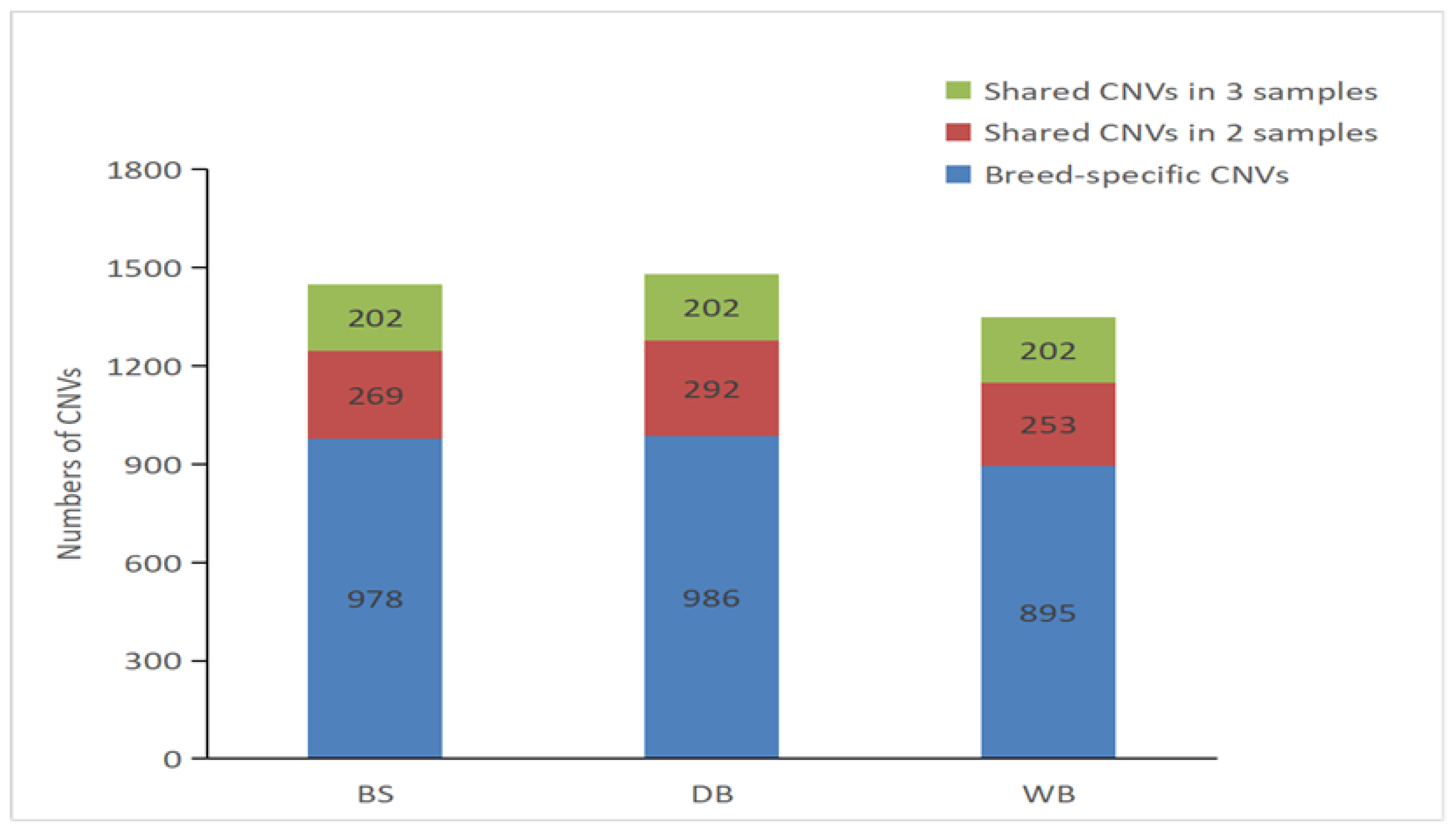
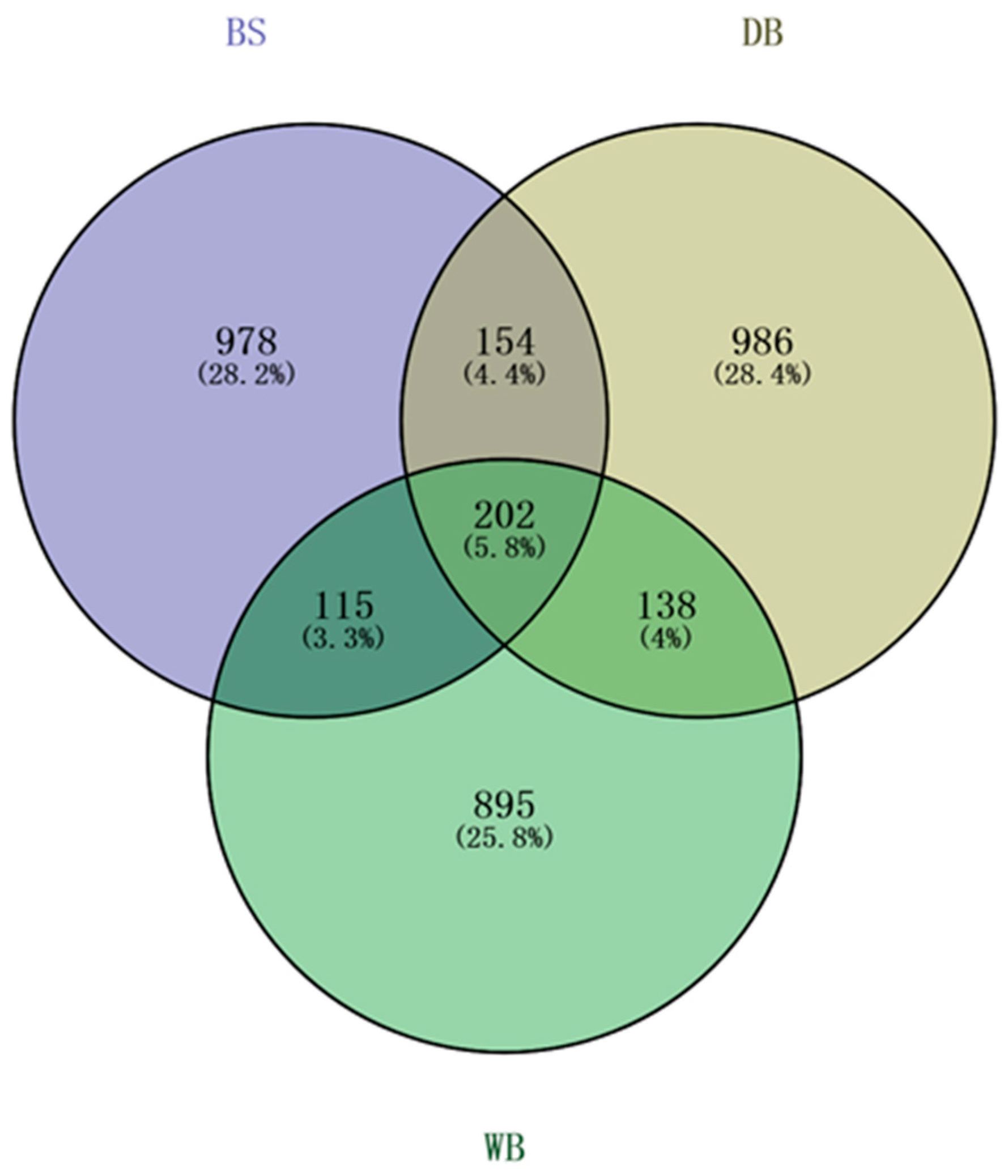
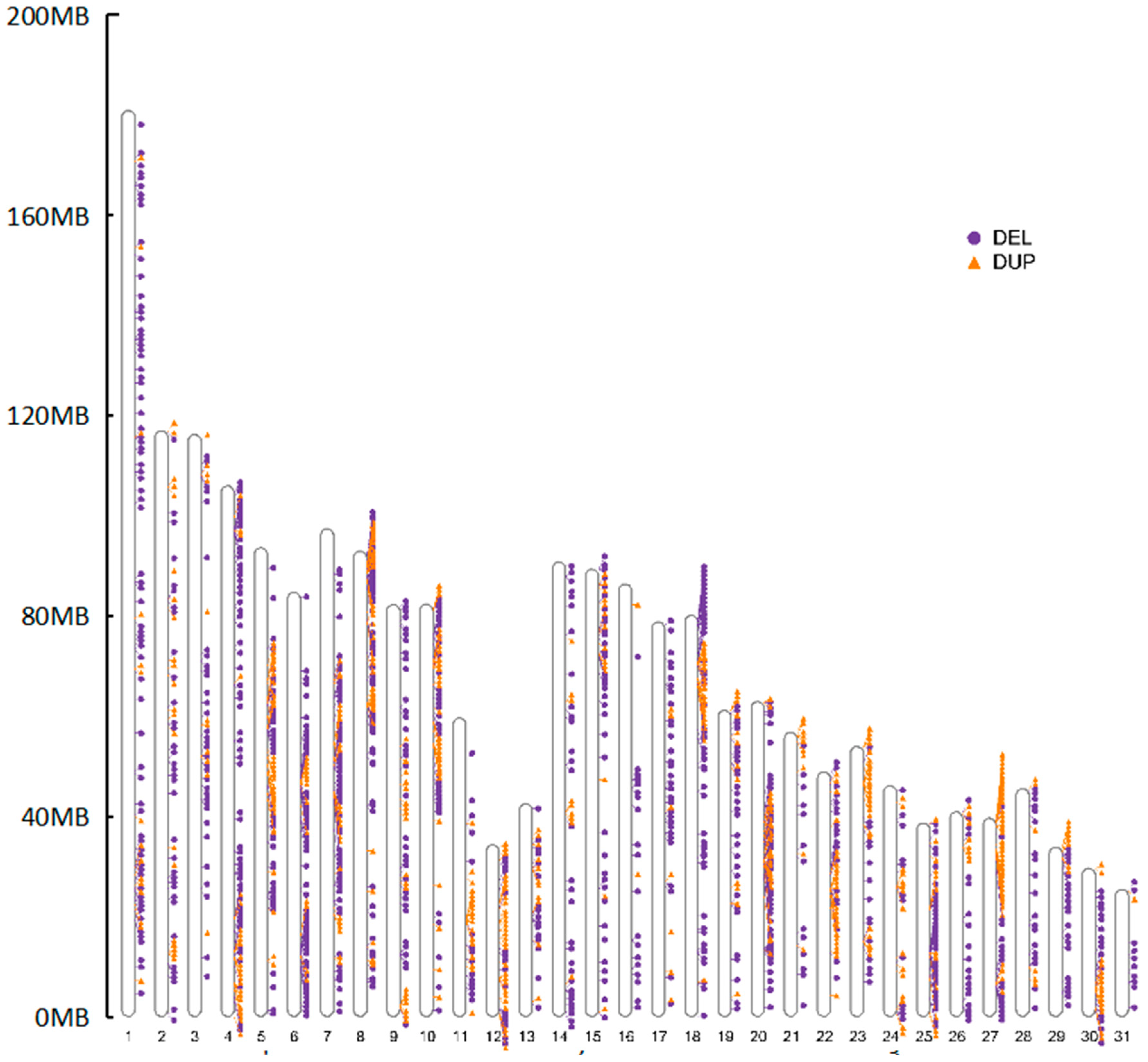
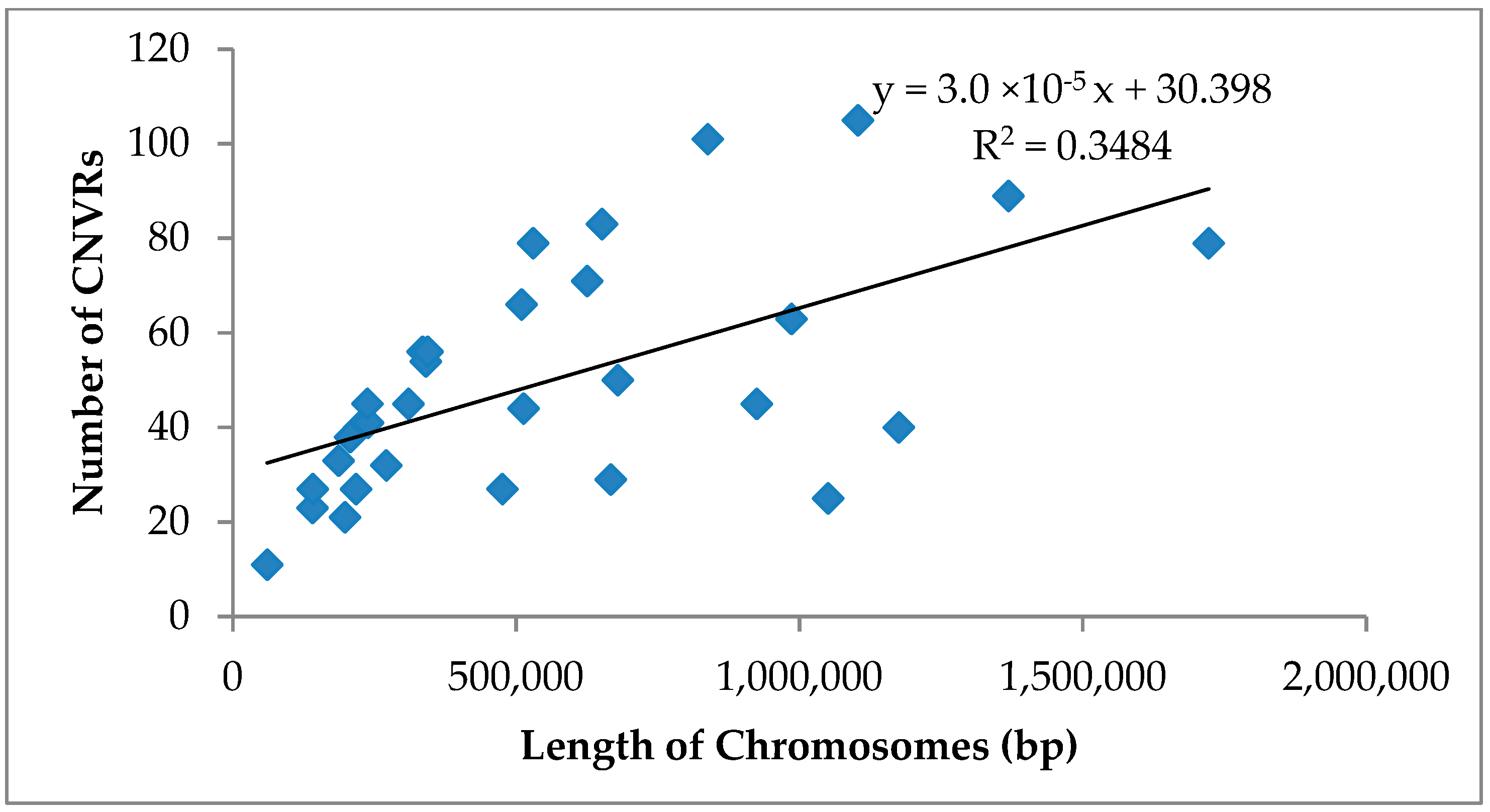
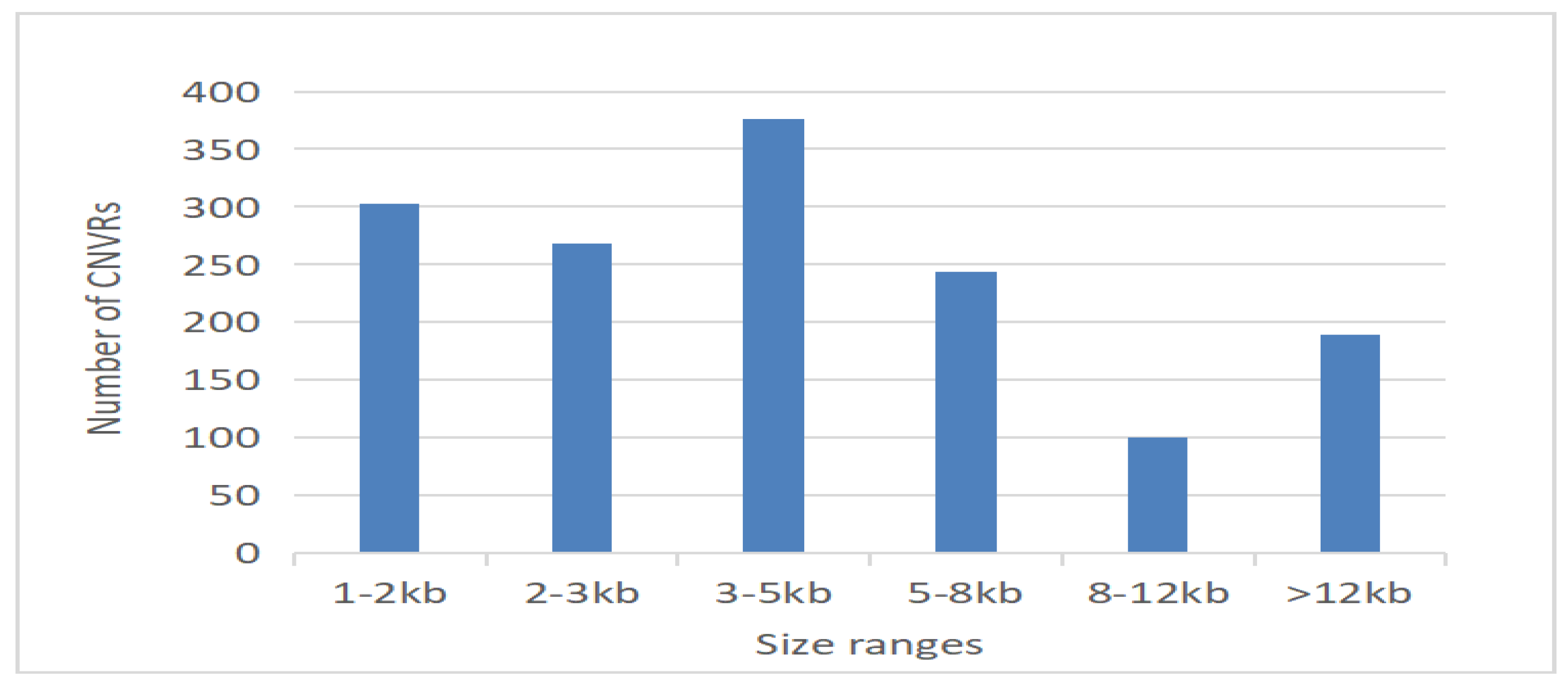
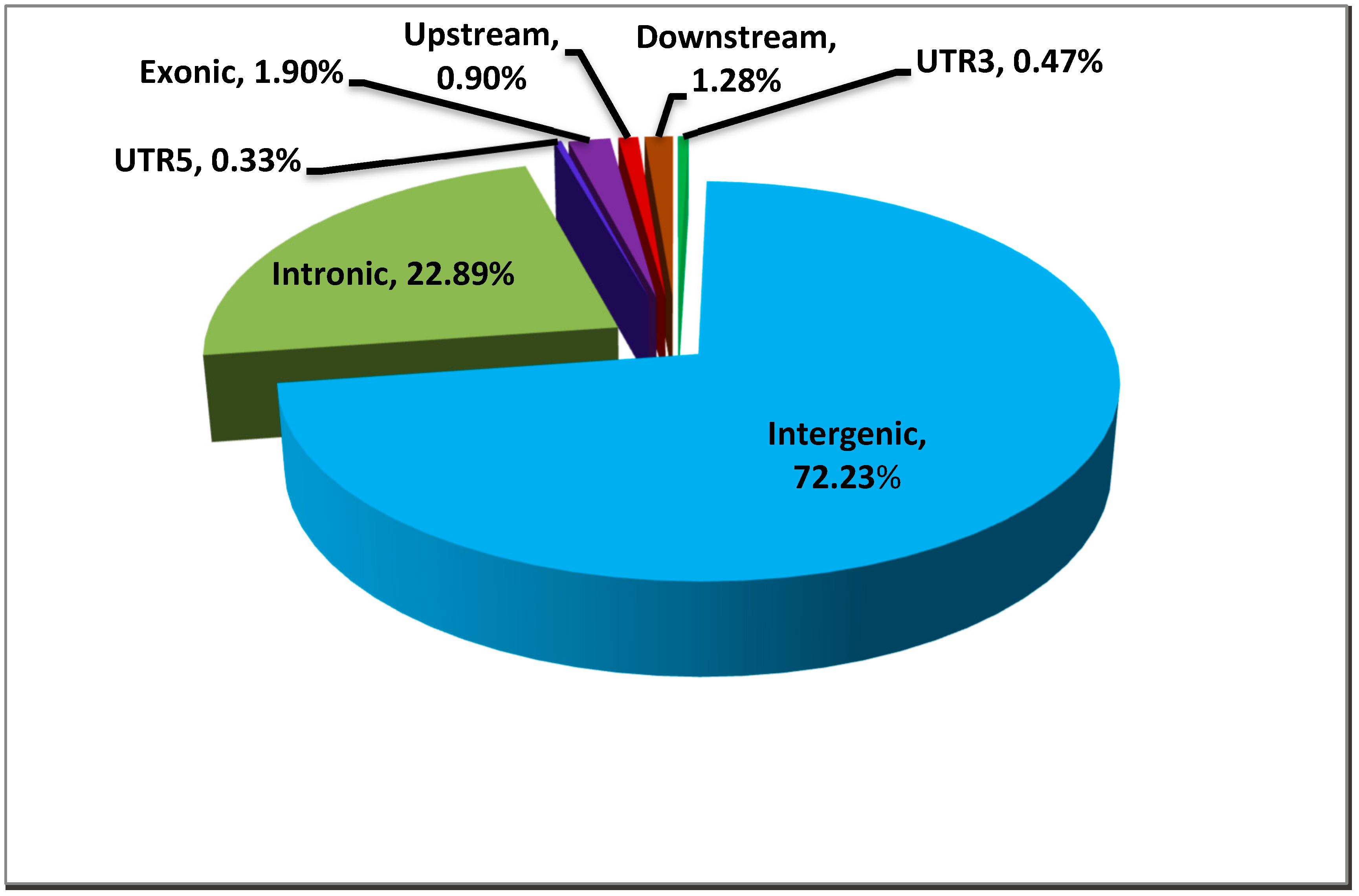
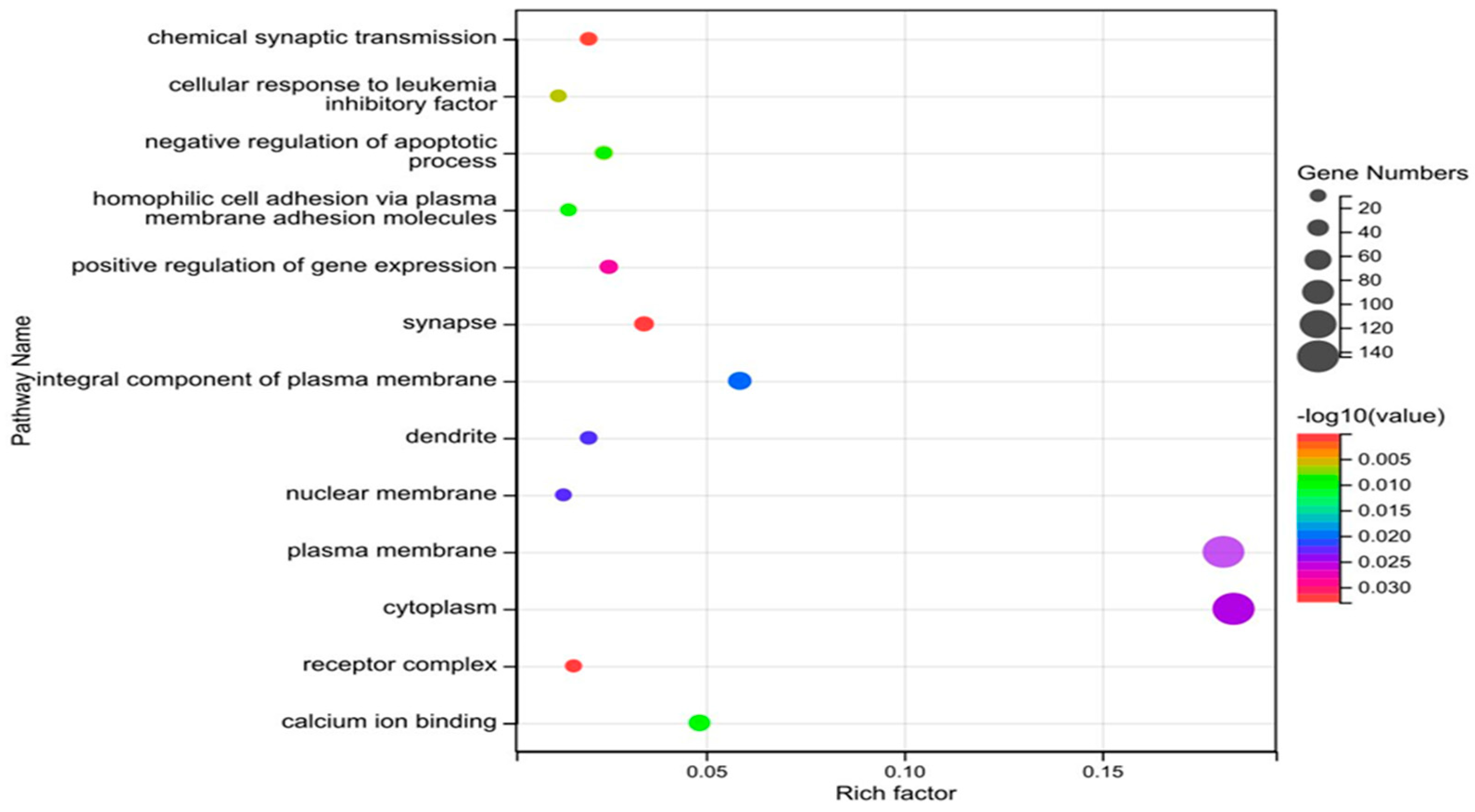
| Breed | Sample Number | Number of CNVs (Breed Specific CNVs) | Average Number of CNVs Per Individual | Average CNV Length (bp) | Range of CNVS Lengths (bp) |
|---|---|---|---|---|---|
| BS | 10 | 6501 (3981) | 650.10 (398.10) | 5295.85 | 1599–485,599 |
| DB | 10 | 6564 (4028) | 656.40 (402.80) | 5199.85 | 1599–891,199 |
| WB | 6 | 5909 (3680) | 984.83 (613.33) | 5598.86 | 1599–453,599 |
| Total | 26 | 18,974 (11,689) | 729.77 (449.58) | 5364.85 | 1599–891,199 |
| Breed | Sample Number | CNVRs | Duplications | Deletions | Average Number of CNVRs Per Individual |
|---|---|---|---|---|---|
| BS | 10 | 1449 (978) | 554 (308) | 895 (670) | 144.90 (97.80) |
| DB | 10 | 1480 (986) | 572 (305) | 908 (681) | 148.00 (98.60) |
| WB | 6 | 1350 (895) | 516 (285) | 834 (610) | 225.00 (149.17) |
| Total | 26 | 4279 (2859) | 1642 (898) | 2637 (1961) | 164.58 (109.96) |
| Chr | Chromosomes Length (Mb) | Number of CNVRs | Length of CNVRs (bp) | Percentage (%) | Average Length of CNVRs (bp) |
|---|---|---|---|---|---|
| chr_1 | 177.90 | 89 | 1,368,311 | 0.73% | 15,374.28 |
| chr_2 | 114.97 | 56 | 334,744 | 0.28% | 5977.57 |
| chr_3 | 114.24 | 45 | 309,955 | 0.26% | 6887.89 |
| chr_4 | 104.15 | 83 | 651,517 | 0.60% | 7849.60 |
| chr_5 | 92.01 | 71 | 625,129 | 0.65% | 8804.63 |
| chr_6 | 83.24 | 63 | 985,937 | 1.13% | 15,649.79 |
| chr_7 | 95.73 | 79 | 1,721,921 | 1.72% | 21,796.47 |
| chr_8 | 91.31 | 101 | 838,299 | 0.88% | 8299.99 |
| chr_9 | 80.83 | 54 | 340,746 | 0.40% | 6310.11 |
| chr_10 | 80.93 | 66 | 509,534 | 0.60% | 7720.21 |
| chr_11 | 58.56 | 33 | 186,767 | 0.30% | 5659.61 |
| chr_12 | 33.69 | 45 | 924,355 | 2.62% | 20,541.22 |
| chr_13 | 41.78 | 27 | 475,973 | 1.09% | 17,628.63 |
| chr_14 | 89.19 | 40 | 223,160 | 0.24% | 5579.00 |
| chr_15 | 87.75 | 50 | 679,150 | 0.74% | 13,583.00 |
| chr_16 | 84.85 | 21 | 198,379 | 0.22% | 9446.62 |
| chr_17 | 77.42 | 38 | 207,162 | 0.26% | 5451.63 |
| chr_18 | 78.73 | 79 | 529,921 | 0.64% | 6707.86 |
| chr_19 | 60.06 | 41 | 238,759 | 0.38% | 5823.39 |
| chr_20 | 61.77 | 105 | 1,102,695 | 1.70% | 10,501.86 |
| chr_21 | 55.74 | 23 | 140,777 | 0.24% | 6120.74 |
| chr_22 | 48.01 | 44 | 513,156 | 1.02% | 11,662.64 |
| chr_23 | 52.94 | 40 | 1,175,160 | 2.12% | 29,379.00 |
| chr_24 | 45.28 | 27 | 217,973 | 0.46% | 8073.07 |
| chr_25 | 37.98 | 45 | 237,555 | 0.60% | 5279.00 |
| chr_26 | 40.14 | 27 | 141,173 | 0.34% | 5228.63 |
| chr_27 | 38.91 | 56 | 343,544 | 0.84% | 6134.71 |
| chr_28 | 44.74 | 25 | 1,050,375 | 2.24% | 42,015.00 |
| chr_29 | 33.23 | 29 | 666,771 | 1.91% | 22,992.10 |
| chr_30 | 29.06 | 32 | 271,168 | 0.89% | 8474.00 |
| chr_31 | 24.94 | 11 | 60,789 | 0.23% | 5526.27 |
| Total | 2160.09 | 1545 | 17,270,855 | 0.76% | 11,178.55 |
| KEGG Pathway | Gene Count | p-Value |
|---|---|---|
| ecb04612:Antigen processing and presentation | 14 | 1.41 × 10−4 |
| ecb05321:Inflammatory bowel disease | 12 | 3.89 × 10−4 |
| ecb04726:Serotonergic synapse | 16 | 4.14 × 10−4 |
| ecb05145:Toxoplasmosis | 15 | 6.58 × 10−4 |
| ecb05150:Staphylococcus aureus infection | 14 | 0.001589502 |
| ecb05323:Rheumatoid arthritis | 13 | 0.001979771 |
| ecb04514:Cell adhesion molecules | 18 | 0.002371425 |
| ecb05332:Graft-versus-host disease | 11 | 0.002491976 |
| ecb05140:Leishmaniasis | 11 | 0.004276101 |
| ecb05330:Allograft rejection | 10 | 0.004827152 |
| ecb04940:Type I diabetes mellitus | 10 | 0.010278294 |
| ecb05416:Viral myocarditis | 10 | 0.010278294 |
| ecb04080:Neuroactive ligand-receptor interaction | 28 | 0.010966373 |
| ecb04742:Taste transduction | 10 | 0.014830627 |
| ecb05320:Autoimmune thyroid disease | 10 | 0.017015378 |
| ecb04921:Oxytocin signaling pathway | 14 | 0.01768501 |
| ecb04640:Hematopoietic cell lineage | 12 | 0.019640595 |
| ecb05166:Human T-cell leukemia virus 1 infection | 19 | 0.026746256 |
| ecb04658:Th1 and Th2 cell differentiation | 10 | 0.028135098 |
| ecb05152:Tuberculosis | 16 | 0.028156201 |
| ecb04530:Tight junction | 15 | 0.03200504 |
| ecb04024:cAMP signaling pathway | 17 | 0.044243718 |
| ecb01100:Metabolic pathways | 86 | 0.048244214 |
| Category | Term | Gene Count | p-Value |
|---|---|---|---|
| GOTERM_BP_DIRECT | GO:0019882~antigen processing and presentation | 10 | 2.39 × 10−5 |
| GOTERM_BP_DIRECT | GO:0007268~chemical synaptic transmission | 15 | 0.00368292 |
| GOTERM_BP_DIRECT | GO:0000902~cell morphogenesis | 10 | 0.005961947 |
| GOTERM_BP_DIRECT | GO:0043066~negative regulation of apoptotic process | 19 | 0.024972288 |
| GOTERM_BP_DIRECT | GO:0035556~intracellular signal transduction | 24 | 0.041473254 |
| GOTERM_BP_DIRECT | GO:0007156~homophilic cell adhesion via plasma membrane adhesion molecules | 11 | 0.046559993 |
| GOTERM_CC_DIRECT | GO:0005887~integral component of plasma membrane | 55 | 0.00307342 |
| GOTERM_CC_DIRECT | GO:0045202~synapse | 23 | 0.009198062 |
| GOTERM_CC_DIRECT | GO:0005737~cytoplasm | 159 | 0.030272449 |
| GOTERM_CC_DIRECT | GO:0009986~cell surface | 24 | 0.041485424 |
| GOTERM_MF_DIRECT | GO:0030594~neurotransmitter receptor activity | 10 | 0.007542982 |
| GOTERM_MF_DIRECT | GO:0005509~calcium ion binding | 41 | 0.011430849 |
| GOTERM_MF_DIRECT | GO:0004712~protein serine/threonine/tyrosine kinase activity | 19 | 0.017675014 |
| GOTERM_MF_DIRECT | GO:0004672~protein kinase activity | 15 | 0.045718707 |
| GOTERM_MF_DIRECT | GO:0020037~heme binding | 13 | 0.047036578 |
| GOTERM_MF_DIRECT | GO:0004674~protein serine/threonine kinase activity | 21 | 0.047891973 |
Disclaimer/Publisher’s Note: The statements, opinions and data contained in all publications are solely those of the individual author(s) and contributor(s) and not of MDPI and/or the editor(s). MDPI and/or the editor(s) disclaim responsibility for any injury to people or property resulting from any ideas, methods, instructions or products referred to in the content. |
© 2023 by the authors. Licensee MDPI, Basel, Switzerland. This article is an open access article distributed under the terms and conditions of the Creative Commons Attribution (CC BY) license (https://creativecommons.org/licenses/by/4.0/).
Share and Cite
Choudhury, M.P.; Wang, Z.; Zhu, M.; Teng, S.; Yan, J.; Cao, S.; Yi, G.; Liu, Y.; Liao, Y.; Tang, Z. Genome-Wide Detection of Copy Number Variations Associated with Miniature Features in Horses. Genes 2023, 14, 1934. https://doi.org/10.3390/genes14101934
Choudhury MP, Wang Z, Zhu M, Teng S, Yan J, Cao S, Yi G, Liu Y, Liao Y, Tang Z. Genome-Wide Detection of Copy Number Variations Associated with Miniature Features in Horses. Genes. 2023; 14(10):1934. https://doi.org/10.3390/genes14101934
Chicago/Turabian StyleChoudhury, Md. Panir, Zihao Wang, Min Zhu, Shaohua Teng, Jing Yan, Shuwei Cao, Guoqiang Yi, Yuwen Liu, Yuying Liao, and Zhonglin Tang. 2023. "Genome-Wide Detection of Copy Number Variations Associated with Miniature Features in Horses" Genes 14, no. 10: 1934. https://doi.org/10.3390/genes14101934
APA StyleChoudhury, M. P., Wang, Z., Zhu, M., Teng, S., Yan, J., Cao, S., Yi, G., Liu, Y., Liao, Y., & Tang, Z. (2023). Genome-Wide Detection of Copy Number Variations Associated with Miniature Features in Horses. Genes, 14(10), 1934. https://doi.org/10.3390/genes14101934







